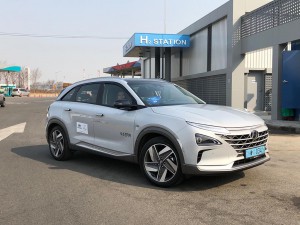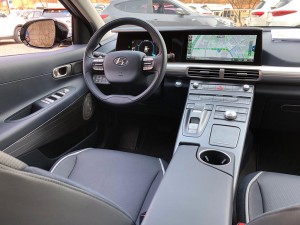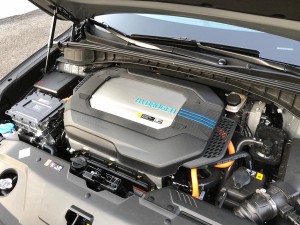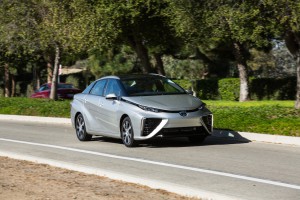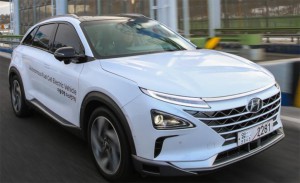
Hyundai offered Winter Olympic visitors a chance to test drive the new Nexo outfitted with its latest Level 4 autonomous drive
With the winter games heading into their final days, busloads of tourists have been flowing through the gates of Pyeonchang’s Olympic Village, but on this crisp, sunny morning, a steady stream of visitors veers off shortly before reaching the turnstiles, detouring to a small, downtown corner where a cluster of new SUVs are parked.
With a little patience, they’ll have the chance to go for a test drive in what some are calling the vehicle of the future – in this case, twice over. The slate gray Hyundai Nexo SUVs are not only powered by zero-emission hydrogen fuel-cells but use the Korean carmaker’s latest Level 4 autonomous vehicle technology.
I climb into the shotgun seat alongside a Hyundai engineer assigned to serve as a backup “operator,” just in case something unexpected happens along the 10-minute route, In passable English, he explains that the Korean carmaker hopes to have its first hands-free vehicle on sale “in a couple years.” But the Nexo itself, he quickly adds, will be in showrooms in barely a year.
The original was a specially modified version of its familiar Tucson crossover, Now, Hyundai is readying its second fuel-cell vehicle and the Nexo has been developed from the ground up specifically to run on the clean-burning fuel. That allows it to eliminate many of the compromises of the Tucson FCV, especially when it comes to interior space.
Nexo is actually the Korean carmaker’s second dedicated green machine, following the Ioniq to market. Visually, it stands in sharp contrast to the Honda Clarity and Toyota Mirai, both of which have adopted radical designs that could have rolled out of a science fiction flick. Then again, it’s far more distinctive than the hydrogen-powered version of the Tucson, with a large parabolic version of the familiar Hyundai grille, crystal-like head and taillights, aero-slick alloy wheels and flush door handles that pop out when you reach for them.
In terms of size, Nexo measures about 184 inches, nose-to-tail, slotting almost evenly between the Tucson, at 176 inches, and the next-generation Hyundai Santa Fe due to market later this year, at 188 inches. It’s got almost precisely the footprint of an Audi Q5, as another comparison.
Inside, the conventional instrument cluster has been replaced by a large, reconfigurable display that adds virtual gauges to track the status of the vehicle’s heart, its fuel-cell stack. A large center console flows into the instrument panel, the forward portion is a somewhat overwhelming maze of buttons and knobs for the audio, climate control and infotainment systems.
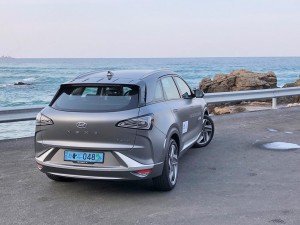
Hydrogen fuel-cells can be thought of as "refillable batteries." And only produce water vapor as exhaust.
Befitting the premium price it is expected to command, Nexo is loaded with a variety of upscale features, including a widescreen, 12.3-inch touchscreen display, as well as many of the latest advanced driver assistance systems, or ADAS.
While the production model won’t quite match up to the autonomous prototype in Pyeonchang, it will have things like forward collision warning with automatic emergency braking and Hyundai’s drive assist. That lets a motorist briefly take hands off the wheel while the car holds its lane and distance from vehicles ahead. Officially, Hyundai says the driver must retake control of the wheel within ten seconds but, in practice, it gave us an average of about 30 seconds of hands-free operation before sounding a warning and threatening to slow down and pull over.
For anyone who spent time in the current Tucson FCV, perhaps the most notable improvement is the fact that Nexo offers a relatively large and comfy interior for four – five in a stretch – with a usable back seat and no compromise to its cargo compartment. That’s because Hyundai engineers designed the new fuel-cell vehicle’s platform around its three hydrogen tanks which are now mounted entirely below the load floor. Meanwhile, the latest-generation fuel-cell stack is about 15% smaller and lighter than the one in the modified Tucson, more in line with the mass of a conventional gasoline engine.
For those unfamiliar with fuel-cell technology, hydrogen is fed into one side of the stack where it passes through layers of permeable plastic membranes coated with exotic catalysts. As the lightweight gas comes into contact with oxygen from the air we breathe it forms water vapor while also leaving behind electrons used to power a vehicle’s electric drivetrain. That’s why some refer to fuel-cells as “refillable batteries.”
In Nexo’s case, however, there is also a small lithium-ion battery pack. If the vehicle were to rely solely on the stack for power a driver would have to wait about a second for the system to respond to a stomp on the throttle, unacceptable when you’re launching off a stoplight or trying to execute a pass. The battery fills in the gaps, essentially eliminating the equivalent of turbo lag. It also adds an extra bit of power during full-out acceleration, and it maintains a reasonable amount of oomph even at highway speeds.
As with conventional electric vehicles, the numbers can be a bit misleading. Though making a seemingly modest 152 brake horsepower, Nexo punches out a hefty 260 pound-feet of torque. It’s by no means a rocket; it needs about 9.5 seconds to hit 60 and tops out at 111 mph. But acceleration is smooth and even and if you weren’t familiar with what’s hidden under the hood you might think you’re behind the wheel of any number of four-cylinder gasoline-powered SUVs.
For those who’ve driven another fuel-cell vehicle, however, Nexo delivers some major improvements in drivability. It’s far quieter than any other FCV we’ve driven, Hyundai engineers all but banishing the unpleasant whine of the compressors needed to push hydrogen and air into the stack.
There’s another advantage to going with a unique platform for Nexo. Hyundai engineers could pack in slightly larger hydrogen tanks – they hold a combined 6.3 kg (13.9 pounds) in highly compressed form. And when you add in the improved aerodynamics of the Nexo body, as well as a 5% improvement in the efficiency of the fuel-cell stack, the new entry is expected to deliver about 400 miles of range between fill-ups. That will handily beat both Mirai and the Clarity FCV. (And the old Tucson FCV, which managed just 265 miles.)
That’s also substantially more than even the longest-range electric vehicles on the market, models like the Tesla Model S P100D.
Both FCVs and EVs have their drawbacks. They’re not cheap. And even with longer-range models an owner has to deal with a lack of an energy infrastructure. But, by comparison, the U.S. network of public charging stations is fleshing out quite rapidly and there’s also the advantage of being able to plug in at home overnight or during the day at work. Right now, there are barely 40 public hydrogen pumps in the entire country, the vast majority of them concentrated in the Greater Los Angeles and San Francisco Bay regions.
California has set aside millions of dollars to expand that to about 100 that it expects will cover the state, even if it means state motorists have to go a bit out of the way to tank up.
There is one key advantage that proponents believe will eventually work in the favor of FCVs like the 2019 Hyundai Nexo: the fact that refueling takes a mere five minutes, or about the same as filling up a gas tank in a conventional Tucson or Santa Fe. But until there are more stations, Hyundai (and Honda and Toyota) is limiting availability, even turning down some potential buyers who simply aren’t close enough to a hydrogen refueling station to make ownership practical.
For those who do, the Nexo likely won’t be cheap. The Tucson FCV has a retail price starting at $50,875, though most folks lease it at $499 a month for three years, with a $2,999 downpayment. That gets them all the hydrogen they can use, too.
The reality is that the new Nexo won’t be for everyone. Indeed, Hyundai won’t even sell it to everyone. But it clearly demonstrates the improvements the industry is making with the latest green machines. For those near a hydrogen pump looking for a fuel-cell vehicle that makes a reasonable attempt at going mainstream, the 2019 Hyundai Nexo is clearly worth considering. It’s certainly setting the new benchmark for the hydrogen niche.

